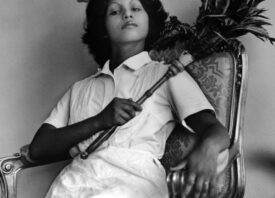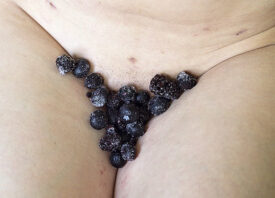Search this site
Reclaiming the Sacred Space of the Divine Feminine in Nature

Ana Mendieta, Volcán, 1979; Six chromogenic color prints, each 13 1/4 x 20 in.; National Museum of Women in the Arts, Promised Gift of Steven Scott, Baltimore, in memory of Hollis Sigler; © The Estate of Ana Mendieta Collection, LLC; Courtesy of Galerie Lelong, New York

Rania Matar, Yara, Cairo, Egypt, 2019; Archival pigment print, 44 x 37 in.; Courtesy of the artist and Robert Klein Gallery; © Rania Matar

Justine Kurland, Jungle Gym, 2001; Chromogenic color print, 30 x 40 in.; National Museum of Women in the Arts, Gift of Heather and Tony Podesta Collection; © Justine Kurland; Image courtesy of the artist and Mitchell-Innes & Nash, New York
Climate change is the manifestation of the destruction of the feminine by a masculine society that believes that humans have dominion over the earth — but as we are seeing it will be Mother Nature who has the last word. The destruction of the planet parallels the oppression and exploitation of women in many cultures around the globe — the erasure of the divine feminine has horrific effects, for the center will not hold.
We are moving well past the tipping point, though this will not be recognized until it is far too late to save the world as it is. Instead, we will enter into a new paradigm where illusions of the past shall be washed away when the glaciers return to claim the lands they inherited from us.
Mother Earth, like the sea, are historically considered feminine entities – a telling truth in a patriarchal world. What Western society has sought to exploit and oppress, perhaps William Congreve said it best in 1697: “Hell hath no fury like a woman scorned.” But why wait until it’s too late?
The new exhibition Live Dangerously, currently on view at the National Museum of Women in the Arts in Washington D.C. through January 20, 2020, presents the work of 12 women photographers who create a new way of seeing and engaging with the natural world.
Featuring the work of Louise Dahl-Wolfe, Anna Gaskell, Dana Hoey, Mwangi Hutter, Graciela Iturbide, Kirsten Justesen, Justine Kurland, Rania Matar, Ana Mendieta, Laurie Simmons, Xaviera Simmons and Janaina Tschäpe. Live Dangerously abandons the conventions of Western art history where female figures in the landscape were presented as emblems of eroticism and fertility in favor of considering nature through the lens of the female gaze.
Among the most radical work is that of Cuban artist Ana Mendieta (1948–1985), whose work literally broke ground using smoke and flames. In her famed Silhuetas from the 1970s, Mendieta marked outlines of her body with gunpowder or sulfur, then ignited the silhouettes, leaving traces of her where her body once laid. It’s an eerie image evoking death scenes not unlike her own, men never punished for murder, the victim bearing the blame. Mendieta used photography and film to document these acts, knowing that the only way to preserve that which cannot be commodified is to record it.
Janaina Tschäpe and Justine Kuland also show images of women’s bodies scattered in the dirt and along the road. Presented in full for the first time, the Tschäpe’s immersive installation “100 Little Deaths” photograph series shows her lying face down in various sites as a means to contemplate her own passing, while simultaneously evoking the anonymous form of so many women killed before their time. It’s an apt metaphor for climate change, which often occurs as something that happens to other people — until it finally hits home.
In Graciela Iturbide’s Mujer Ángel, Desierto de Sonora (Angel Woman, Sonoran Desert), the resurrection comes — a sense offering a vision of something that exists beyond this realm, the possibility for salvation and redemption if we do right by the earth and the fruit it bears. Through this image, and those in the show, we may consider the significance of reclaiming sacred space of the divine feminine and protecting it from…ourselves.

Graciela Iturbide, Mujer Ángel, Desierto de Sonora (Angel Woman, Sonoran Desert), 1979 (printed 2014); Gelatin silver print, 16 x 20 in.; National Museum of Women in the Arts, Gift of Cindy Jones; © Graciela Iturbide; Image courtesy of Throckmorton Fine Art, New York

Justine Kurland, Slumber Party, 2000; Chromogenic color print, 30 x 40 in.; National Museum of Women in the Arts, Gift of Heather and Tony Podesta Collection; © Justine Kurland; Image courtesy of the artist and Mitchell-Innes & Nash, New York

Janaina Tschäpe, Frick Park, from the series “100 Little Deaths,” 2000; Chromogenic color print, 31 x 47 in.; National Museum of Women in the Arts, Gift of Heather and Tony Podesta Collection; © Ja- naina Tschäpe; Image courtesy of Janaina Tschäpe studio

Janaina Tschäpe, Weimar, from the series “100 Little Deaths,” 1998; Chromogenic color print, 31 x 47 in.; National Museum of Women in the Arts, Gift of Heather and Tony Podesta Collection; © Janaina Tschäpe; Image courtesy of Janaina Tschäpe studio

Janaina Tschäpe, Moais, from the series “100 Little Deaths,” 2002; Chromogenic color print, 31 x 47 in.; National Museum of Women in the Arts, Gift of Heather and Tony Podesta Collection; © Janaina Tschäpe; Image courtesy of Janaina Tschäpe studio


